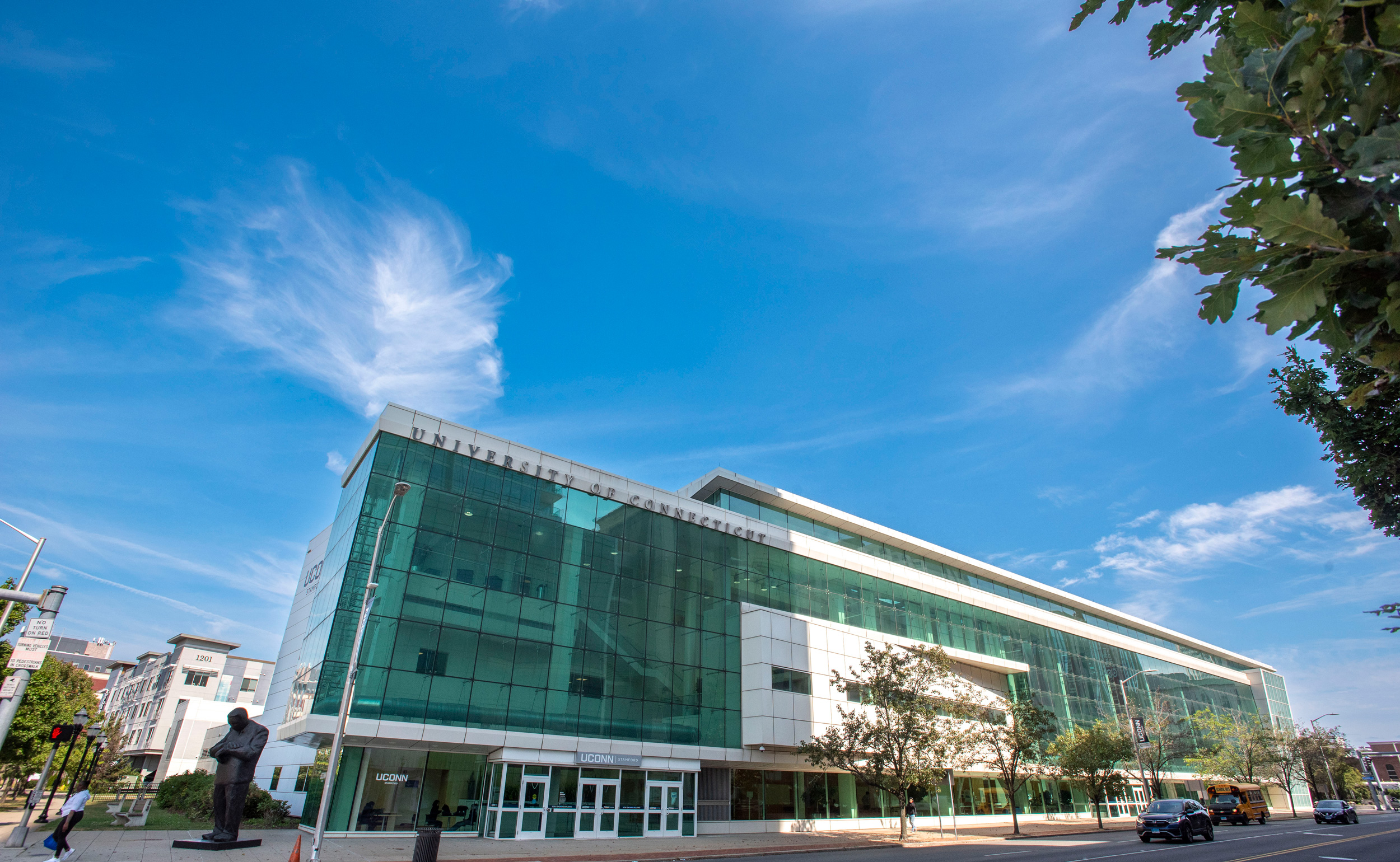About UConn Stamford
About UConn Stamford
In-Demand Industries. In-Demand Skills.
UConn Stamford offers innovative programs that prepare students to enter in-demand industries. From our rigorous undergraduate programs to top-ranked graduate and professional programs, we have built a vibrant, urban community for the next generation of Huskies.
Our downtown location is located in the heart of Stamford, an economically vibrant and innovative city that provides students with unbeatable access to internships, co-ops, field placements, and jobs with top companies, non-profit organizations, and civic, educational, and community agencies. We are just 34 miles and less than an hour by train from New York City. With access to Connecticut’s beaches, the Long Island Sound, and a variety of suburban and rural towns, UConn Stamford’s location is the best of all worlds.
We proudly offer on-campus housing for students, comprehensive academic resources, and a range of unique opportunities. At the Synchrony Digital Technology Center, students learn from technology experts on how to commercialize solutions for the company’s partners. As a hub for data science, UConn Stamford creates opportunities for students, faculty and researchers, and entreprenseurs with programs such as TIP Digital.
Campus Leadership

Jennifer E. Orlikoff, Ph.D.
Campus Dean & Chief Administrative Officer
Dr. Jennifer E. Orlikoff is the dean & chief administrative officer of UConn Stamford. As a campus leader and strong proponent of diversity, equity, and inclusion, Dr. Orlikoff is committed to ensuring a positive experience for students, faculty, and staff by fostering a united and inclusive campus community. With UConn Stamford’s focus on cutting-edge programs, access to education, and affordability, she is dedicated to helping every student succeed through a wide range of services and activities, and promoting transformational change for the community, region, and state.
Dr. Orlikoff earned her master of arts and Ph.D. degrees in french literature from Rutgers University. She received her bachelor of arts in french and art history with honors from the University of Wisconsin – Madison. Prior to joining UConn, Dr. Orlikoff served as campus president of Potomac State College at West Virginia University from 2016 through 2022. Before her appointment as chief administrative officer, she served West Virginia University’s Morgantown campus as director of the WVU Center for Women’s and Gender Studies and a range of academic leadership positions. She has been a visiting faculty member at the Royal University for Women in Bahrain and taught at Rutgers University, University of Memphis, and public schools in New Jersey. Orlikoff’s background also includes over ten years of experience in business where she was vice president of international services and chief communication officer for Assist America, an international emergency medical travel assistance company.
Our campus administration is made up of a dedicated team of leaders and staff who support UConn Stamford and our students, faculty, and staff.
Our Mission
The University is internationally recognized for research in wide-ranging areas, and in the spirit of our heritage as a land and sea grant institution, we remain committed to understanding and solving the most significant societal problems. We approach our mission with a commitment to excellence, ethical action, and inclusiveness for which the four interdependent core values define our mission: innovation, leadership, global engagement, and diversity.

Commitment to Diversity
At UConn Stamford, we are committed to building a safe and inclusive community for all members of our community through diversity, equity, and inclusion (DEI). We are a federally eligible minority/hispanic-serving institution.
Undergraduates
70% are students of color and
55% are first-generation college students.
Graduate Students
25% are students of color.
International Students
make up 5% of our undergraduates and 39% of our graduate students.
History
In 1951, the University of Connecticut began offering extension courses at the former Stamford High School. In fall of 1952, the University formally established a regional campus in Stamford. Upon inception, UConn’s Stamford Campus offered five courses — English, Mathematics, History, Speech and Sociology and enrolled 21 part-time students.
A newly constructed UConn Stamford Campus opened in 1962 on Scofield Town Road, and a separate library building was added in 1974. Also in the mid-1970s, the academic program was expanded to provide a four-year degree in several fields of study.
In 1990, planning began for a new UConn Stamford Campus in the heart of downtown Stamford. One of the first UConn 2000 building projects, the new state-of-the-art campus opened in 1998, offering a variety of academic programs including undergraduate and graduate degrees.
The contemporary glass-enclosed campus features a high-tech approach to learning from desktop computer stations in our main computer lab to integrated online computer accessibility in our classrooms, laboratories and public spaces.
History
In 1951, the University of Connecticut began offering extension courses at the former Stamford High School. In fall of 1952, the University formally established a regional campus in Stamford. Upon inception, UConn’s Stamford Campus offered five courses — English, Mathematics, History, Speech and Sociology and enrolled 21 part-time students.
A newly constructed UConn Stamford Campus opened in 1962 on Scofield Town Road, and a separate library building was added in 1974. Also in the mid-1970s, the academic program was expanded to provide a four-year degree in several fields of study.
In 1990, planning began for a new UConn Stamford Campus in the heart of downtown Stamford. One of the first UConn 2000 building projects, the new state-of-the-art campus opened in 1998, offering a variety of academic programs including undergraduate and graduate degrees.
The contemporary glass-enclosed campus features a high-tech approach to learning from desktop computer stations in our main computer lab to integrated online computer accessibility in our classrooms, laboratories and public spaces.
